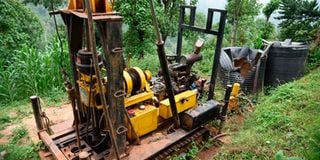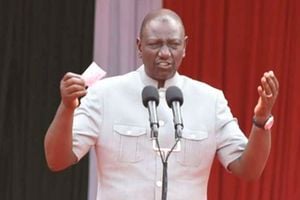Who’ll stop ‘budgeted corruption’?

Abandoned equipment at Kipsaiya in Elgeyo Marakwet where Arror dam was to be built.
What is the biggest contributor to the unsustainable debt situation we face as a country today? Is it just a case of imprudent borrowing or is it because the government has developed a bigger appetite for expensive loans?
In my view, corruption is the single most important factor and cause of the rapid accumulation of the expensive commercial loans that sit in our books today.
I return to this subject because of the haranguing I was subjected to last week by a former Cabinet Secretary, who sent me a lengthy note disagreeing with the views I expressed in a previous article. I had described the Kimwarer and Arror dams projects as examples of kick-back-motivated projects that have saddled the taxpayer with expensive debts.
The former CS accused me of ignoring the political angle to the saga and insisted that the projects collapsed due to political machinations by a faction within the Jubilee administration. He predicted that the ongoing court case against senior public officials will collapse.
External debt register
I choose to go by facts. As we all know, the single source of truth on matters to do with external debt is the external debt register. This is a public document where you get details such as the size of the loan taken out, its repayment terms and the reason for which the money was borrowed.
The latest published external debt register covers up to June 2020. The facts disclosed about the money we borrowed for Kimwarer and Arror dams are as follows: First, the amount borrowed for the two projects is stated as USD577 million (Sh71 billion). Secondly, the lender on record is Intessa Sao Paolo, of Italy. Thirdly, the taxpayer must repay the loan until November 2035.
If this is not corruption, then you must show me where and on what these billions were spent. The dams don’t exist. If it is not corruption, then you must explain to me why the National Treasury went ahead to commit the country to these expensive loans despite the fact that Kenya Forest Service is—to date—yet to de-gazette the land on which the dams were to be built?
As you go through the external register, you don’t see a correlation between the money we have borrowed from foreigners and success and timely completion of projects. The hard currency-denominated debts just keep piling. In 2014, we borrowed a massive USD71 million (Sh8.3 billion) for the Galana-Kulalu irrigation scheme from Bank Leumi, of Israel.
Massive debt
Despite the fact that Israeli contractor Green Avara abandoned the project in 2019 after being paid Sh5.9 billion, the taxpayer will still repay the dollar loan to Bank Leumi until 30th September, 2033.
The Itare dam project, in Nakuru County, stalled in 2018. Yet, according to the data in the external debt register, we have a massive debt of Sh35. 9 billion (USD306 million) from Intessa Sao Paolo Bank, which we must service until 10th September, 2034.
It is a matter of public record that one of the most expensive projects in the energy sector was the building of the transmission power line connecting Lake Turkana Wind Power to the national grid.
Due to delays in construction of the line, the government paid a whopping Sh18 billion to the Lake Turkana Power Company in so-called deemed generated energy for the period between January 2017 to September 2018. Though perfectly legal, the taxpayer paid for thin air.
The Ministry of Energy disbursed another Sh17.6 billion to Ketraco for this line between 2013 and 2019. In August 2017, the Spanish contractor building the line was declared bankrupt in Spain, forcing Ketraco to terminate the contract—but after paying them Sh10 billion. The Chinese contractor brought in to complete the project, Messrs Nari Group Corporation, was contracted at another Sh9 billion.
The external register shows that we still have an expensive Sh6.7 billion (USD55 million) debt, which the taxpayer must service until October 2050.
Since 2014, we have borrowed billions of shillings from the African Development Fund, of France, and China Exim Bank to fund the Menengai geothermal project. Not even one megawatt of power has been produced in the almost 10 years.
Due to graft, our external debt register is saddled with too many expensive commercial debts. The budgeting degenerated into a vendor-driven affair, whereby corrupt and well-connected elites collude with vulture-like yield-hungry European creditors to push their pet projects through the back door into the national budget for selfish personal gain.
I fully support the idea in the Azimio la Umoja One Kenya Coalition Party manifesto of creating an Office of Budget Management. Radical institutional reform is how we can rein in this new phenomenon we call “budgeted corruption”.




